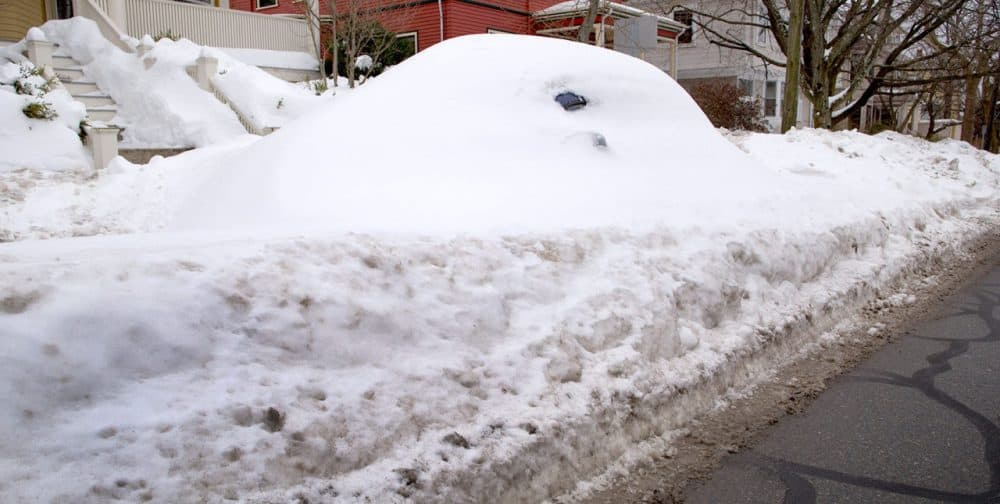Advertisement
What Happens To Your Car If You Didn't Shovel It Out This Winter

You've all seen them. It's been a brutal winter, and with the record snowfall, many people simply gave up on shoveling out their cars.
And now, with the warmest temperatures we've seen since Christmas, some of these snowed-in cars are finally starting to peek through.
So, we wondered, what happens to your car if you left it buried in snow these past two months? It sounded like a question for Car Talk.
Luckily, the great Ray Magliozzi, of Car Talk, was here at WBUR Wednesday. We stopped him in the hall, and put our question to him.
He said for the most part leaving your car buried in snow shouldn't be a problem, but there are a few kinks that will need to be worked out.
Here's what Magliozzi had to say about getting "reacquainted" with your vehicle after the historic winter, as well as some advice for next winter — or heaven forbid the next snowstorm this season (lightly edited):

What happens to your car if you were one of the many people who gave up this winter and left buried in snow?
This winter was just so overwhelming after the second storm, people just said “Uncle. I give up.” So what happens to your car? A lot of people ask me the same question: Is the weight of the snow a concern? No, because if you put a couple of mothers-in-law in there, that’s equal the weight of the snow [laughs]. Passengers in the car are going to add much more weight to the car than the snow no matter how much you get, unless you get 10 feet or something.
What really happens to the car is the inactivity and any car, whether it’s covered with snow or it’s not covered with snow, that sits around for a long period of time is going to suffer from the kinds of things that inactivity gives you — things like rust and freeze-up. I don’t mean freeze with coldness, but door locks won’t work, your brakes get all rusty, and then there’s just the possibility that you don’t even recognize the car when you dig out, and you say, "Wait, this isn't my car."
I think that once you get your car dug out — and there’s no reason to dig it out if you’re not going to use it — you gotta just take your chances that things are not going to work that had worked before, but might have been on the brink of not working. So, if it’s an older car you’re going to find things that don’t work now because they were ready to break anyway. For example if your muffler falls off when you first drive the car, well that was going to happen anyway. It’s just that you happen to park it two days or a week before it was scheduled to fall off and you put it off for two months or whatever.
This winter brought plenty of snow, but also arctic temperatures. Is there any type of damage that can happen from all the snow and the deep freeze we experienced?
Well as far as the coldness goes, your car is an inanimate object, so it doesn't feel the cold the way we do [laughs]. So, even if the windchill is 20 below zero, the car doesn't care and don’t forget it’s insulated with all that snow so it’s not getting as cold as it would. But, I don't think things are going to fail any faster from having the car either surrounded by snow or in freezing cold temperatures than they would if the car weren't surrounded by snow.
For example, your tires, because they haven't been turned for many, many weeks, probably are going to develop flat spots, so when you first start to drive the car you’re going to hear “thump, thump, thump, thump, thump, thump, thump” and that will go away after 20 miles or 100 miles or whatever. And if it doesn't go away you’re probably going to need new tires or maybe you would have needed them anyway. But as far as the weight and the coldness I don’t think there’s anything to worry about.
Our shop is right in Cambridge [and] for years we've had customers, even with a lot less snow than this, who have just left their cars for the whole winter and sometimes your battery goes dead, which is likely, especially a newer car, so you might need a jump start. You’re going to lose all the stations that you had set on the radio, all those are going to be wiped out, so you’ll have to get the book out and find out how to reset your stations. And the computer is going to have to relearn things, because the computer stores information about how you drive the car and when the battery goes dead a lot of that stuff gets wiped out. So, when you first get it started it may run poorly, it may not shift right, and there’s going to be a period where you have to get reacquainted with your car and your car has to get reacquainted with you. It has to know, “Hey, who is this behind the wheel? Oh, I remember you. You left me in the snow for two months. Sure, I’m not going to behave well, I’m going to give you a reminder that you abandoned me for a long time."
"'Hey, who is this behind the wheel? Oh, I remember you. You left me in the snow for two months. Sure, I’m not going to behave well, I’m going to give you a reminder that you abandoned me for a long time.' ”
Ray Magliozzi
So nothing would happen to the paint, windows or anything else?
No. All that stuff is tough. Let’s look at your leather seats for example, if you’re so lucky to have leather seats. Your leather seats are more likely to crack if you’re getting into the thing every morning when it’s 0 degrees out. So, your car’s parked outside, it’s 5 degrees, you get in and sit your warm butt on the cold leather seat and that leather gets to move around and whatnot. I think you just increase the chances that you do damage when you drive the car. So, it might be advantageous to not drive the car so far as wear and tear on certain thing like leather seats, door handles and whatnot that are going to be affected by your using them when they’re really cold.
OK, to be clear you're saying it's not really not a major issue to leave your car buried in snow?
Yeah. I mean there are consequences. You’re brakes are going to be all rusted so when you first start to drive it, you're going to hear all this scraping sound and whatnot. Again, if something awful were to happen it was probably going to happen anyway. So, if a caliper was seizing up and this was like the final stage by parking your car, that was going to happen no matter what ... but no, there’s no single thing I think that you can do to your car by doing it. And the evidence is, we've had customers that have done it for years and years and years and they seem to be alright.
Of course, it’s a problem for us because we don't see these people for a couple of months of winter, then they all come in like the same day and they want to get their cars fixed because they’re planning a trip to D.C. We say, “Oh, where have you been for the last month and a half?” [They say,] “Oh, my car’s been parked out in front of the house.” So, I think you just leave the car and you take your chances.
Do you have any advice for people who gave up on their cars?
I would say if you did anything, if you dig out where the tail pipe is and you could get your driver's door open, it would be nice if you ran the engine for maybe 10 minutes or so once a week. If you did that, you would exercise the engine, you’d get the oil moving around, you’d get some oil splash from the cylinder walls, you’d be less likely to get the engine rusted up and you would recharged the battery so it wouldn't go dead and you wouldn't have to go through that whole relearn thing with the computer and all that. So, you don’t have to dig the car out because we know what happens when we did the car out — you lose your spot. And when you lose your spot, you’re done for.
So, this is advice for next winter because it’s too late now: I think anyone whose car has been sitting for this period of time probably has a dead battery already so now you have to shovel off the hood, and be very careful when you’re shoveling out the car because it’s easy to scratch the paint. So be careful. Get the driver’s door open if you can and if you can get it started great, if you can’t, shovel off the hood [and] get someone to jump you, run the thing for 10 or 15 minutes and don’t try to move it because you won’t be able to unless you dig it out completely. But, if you dig it out completely, you better be ready to look for another spot because they’re still at a premium.
Well, now that we have this warmer weather and are sort of in a thaw — it’s a little bit sunnier and we have more daylight with the time change — what do you say to these drivers after this brutal winter?
Well, it’s great to get out and drive your car. This might be the time to dig out. I think by this weekend, I think you’re going to see a lot of people digging out their cars. My only advice would be to be gentle with it. Don’t go driving it at 75 mph for 300 miles. Drive around town, see what’s going wrong, see what noises it's making and see if you remember the car [laughs].
-- And here are a few examples of cars that were left behind this winter:
a) buried caror
b) snow pile? pic.twitter.com/QVClakH0Kn
— Ben Swasey (@benswasey) February 14, 2015
Sign says "car buried under this pile!!!" #Boston pic.twitter.com/Uvttwnxnl1— wifi material (@melbatoastmarie) March 8, 2015
A buried car is the ultimate #spacesaver #boston #MAsnow pic.twitter.com/1VohkwEOdm— Warren Serink (@mooseNYC) March 3, 2015
Car buried in #snow in #Boston! RT@MarlaSanford: Car has been junified #Juno #juno2015 #junoboston @weatherchannel pic.twitter.com/Xbyo4hXkps